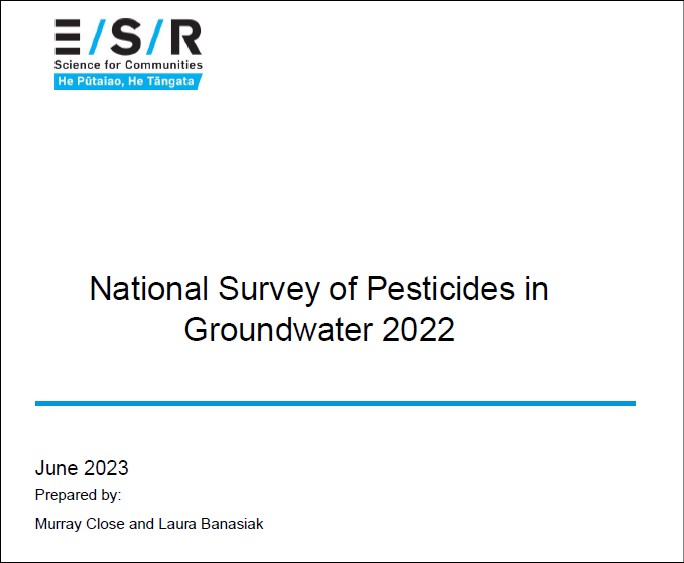National survey of pesticides in groundwater 2022
Author:
Murray Close, Laura Banasiak, ESR, Institute of Environmental Science and Research LimitedSource:
ESR, Institute of Environmental Science and Research LimitedPublication date:
2023Topics:
EnvironmentExecutive summary
In 2022, ESR coordinated a survey of pesticides in groundwater throughout Aotearoa New Zealand. The pesticide survey has been completed every four years since 1990, with 2022 being the ninth consecutive survey. Regional and Unitary Authorties carried out the well sampling and the 2022 survey was the first time that per- and polyfluoralkylsubstances (PFAS) were included in the suite of compounds analysed. The pesticide analysis was carried out by Hills Laboratories. Emerging Organic Contaminants (EOCs) were also analysed but the results are not available for this report. ESR’s role was to coordinate the survey, advise on well selection, collate and interpret the results and produce a summary report.
Wells were selected based on several factors including the importance of an aquifer to a region, the known application and storage of pesticides in the area, and the perceived vulnerability of the aquifer to pesticide contamination. Where possible, wells sampled in previous surveys were included in the 2022 survey to give a temporal comparison. Most of the sampled wells are screened in unconfined aquifers and were selected because shallower unconfined aquifers are at greater risk of contamination than confined, deeper aquifers.
In total, 184 wells were sampled, including an additional 21 wells from Waikato Regional Council that had been sampled as part of their regional surveys between January 2020 and June 2022. Pesticides were detected in 17 wells (9.2%), with 6 (3.3%) of these wells having two or more pesticides detected. The maximum number of pesticides detected in one well was six. Pesticides were not detected in wells from Auckland Council (8 wells), Bay of Plenty Regional Council (10 wells), Hawkes Bay Regional Council (12 wells), and Greater Wellington Regional Council (8 wells). Sixteen different pesticides were detected in the sampled wells, with herbicides being the most frequently detected pesticide group with 19 detections (66%) of 12 different herbicides and their metabolites. The most commonly detected pesticide was terbuthylazine (detected in 6 wells), followed by desethyl terbuthylazine (DET) (detected in 4 wells). Only one pesticide detection concentration exceeded 1 μg/L (clopyralid, 1.1 μg/L). There is no Maximum Acceptable Value (MAV) for drinking water available for clopyralid. Dieldrin was detected above the MAV for drinking water in one well, at a maximum concentration of 0.053 μg/L (i.e., 133% of the MAV of 0.04 μg/L (Taumata Arowai (2022)). Concentrations of other detected pesticides were less than 4% of their respective MAV.
Compared to the pesticide survey of 2018, the number of pesticide detections has decreased. In 2018 24% of wells had pesticides detected but in the 2022 survey this had dropped to 9%. Analysis of wells sampled in 2022 that had been sampled in multiple previous surveys indicate that there were 2 wells with significant (p<0.05) decreases over time and a further well with a decrease at the p<0.1 level. 26 of the 56 wells that had been sampled in 2022, and had also been sampled in 4 or more previous surveys, had no pesticides detected on any occasion. As these surveys have been focused on shallow unconfined groundwater systems, which are most at risk of pesticide contamination, this indicates that most groundwater in New Zealand should be considered safe to drink with respect to pesticides. Overall, our data from the 2022 national groundwater survey indicate a decrease in the frequency and concentration of pesticide residues detected in groundwater relative to previous surveys.
There is limited discussion in this report about the correlation of pesticide detections with parameters such as well depth and groundwater chemistry. It was felt that it was more important to provide the actual results of the survey of pesticides in groundwater to the regional councils as soon as possible. Further analysis of the data is continuing, and more extensive discussion will be provided in a journal paper that will be prepared for publication and sent to all the councils as soon as it is ready. ...
ESR, Institute of Environmental Science and Research Limited. June 2023
